
The Effect of Musical Emotional Perception on Reverberation
Reverberation is the sound energy emitted from the sound source in the room, reflected back and forth in the direction of the propagation, and gradually absorbed by the wall and gradually decay phenomenon. The existence of indoor reverberation has long been noted that since Sabin found that reverberation time formula, the design and control of indoor sound from the experience and art into a relatively rational stage, reverberation time to become the basic concept of indoor acoustics and Determine the most important indoor sound quality, and even the only parameters that can be manipulated. This paper investigates the influence of reverberation time on the subjective feelings of music, that is, the influence of music emotion perception. The experiment is divided into two steps, the first is the subjective evaluation of the music emotion, the music material in the emotional value of the psychological values, and extract the emotional weight of the music; and then according to the music emotional perception results chooseed music material and its different Reverberation, through the subjective listening experiment to examine the impact of reverberation on the emotional perception of music.
1 subjective judgment of music emotion
1.1 Music material chooseed 90 pieces of folk music as experimental material, its unified reverberation. In the vicinity of 1.3s, the reverberation time response of reverberation time is 1.3s and the 90 pieces of music are convolved separately to get the listening material. The results are based on continuous mixing
To the signal of the tail are unified treatment, in order to avoid the impact of the end of reverberation. The 90 people used in the experiment are listed in Table 1. Table 1 for the listening test of the folk music material 1.2 Judgment method based on the description of the basic emotions to cover the music, a total of 26: joy, sadness, passion, comfort, happiness, sadness, strength, peace, pleasure, depression, Leisurely, mysterious, sweet, gentle, free, tenderness, vitality, leisurely, sacred, fantastic, quiet, soft, quiet, helpless. In the experiment, the series of category method is used to judge the emotion description with the five-level evaluation scale. The strong degree of emotion is carried out according to the incremental scale, followed by weak, weak, medium, strong and strong. 90 music signals were randomly disrupted, each signal put three times, asked the subjects to the evaluation table given in the emotional description of the words and the corresponding degree of emotional check. If you think that does not involve such emotions, you can skip the unchecked, the next indicator of the level of judgment. The experimental environment for the standard listening room, the use of headphone mono playback mode, ear mouth sound pressure level remained at 75dBA around a total of 19 subjects involved in the experiment. 1.3 Analysis of the results of the results According to the results of subjective experiments, the results of the evaluation of the statistics, the corresponding 90 signals in the 26 evaluation of the psychological scale values and principal component analysis, extracted four emotional principal components. (1) the first emotional main component is happy, relaxed, melancholy, helpless, happy, happy, free, sad, these emotions contain the emotional tone of the positive and negative emotions, so the first emotional principal component is defined as Emotional feelings of sadness; (2) the second emotional principal component has passion, strength, gentle, concentrated expression of emotional tension or relaxation, therefore, the second emotional principal component is defined as the intensity of emotion; (3) (4) the fourth emotional principal component has a dream, mysterious, sacred, therefore, the fourth emotional principal component is defined as sacred. (4) The third emotional principal component is defined as sacred degree. The effect of reverberation on the perception of music emotion After experiencing the emotional evaluation of music, it is found that many emotions are not single and may contain multiple emotions. Therefore, in the study of the impact of reverberation time on the emotional perception of music experience, choose the music emotional tendencies more obvious music material, a total of 30 first. In the emotional perception of strength before the judge must let the subjects of music emotions to reach a consensus, and with accurate semantic vocabulary description of the repertoire of the emotions, and according to the emotional feelings of the feelings of music to judge. Will be the 30 music to reach a consensus of the emotions can be five categories: happy class, including joy, joy, joy, joy and other emotions; sad class, including sadness, helplessness, depression, sadness; leisure class contains leisurely, leisure; , Contains soft, tranquility, tenderness, serenity; sacred class, contains sacred, mysterious. According to the emotional classification of 30 tracks will be classified, as shown in Table 2. Reverberation control is achieved by reverberation time. In order to control other variables except the reverberation time, a fixed hall in the Odeon software is chooseed to produce a room impulse response signal that reflects the reverberation state. Keep the room space structure, size and listening position unchanged, only to even change the rooms sound absorption, get reverberation time were 0.5s, 1.0s, 1.5s, 2.0s, 3.0s, 4.0s, 5.0 s, 7.0s of the room impulse response signal, with the music signal convolution after the end of the signal are a unified fade out processing.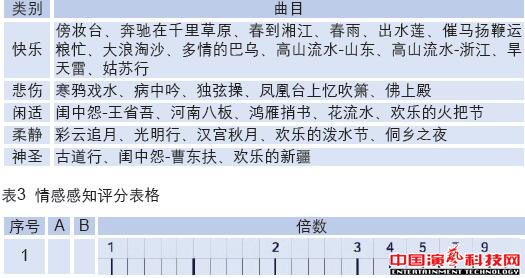 Table 2 classification of music tracks 2.1 subjective evaluation of the experimental judgment of the emotional sensitivity of the emotional evaluation of the way is the scale of the method of assessment. Take each track as an example, with eight different reverberation time of the impulse response signal convolution after a total of eight listening signals. The signal with the reverberation time of 1.5 s is set as the reference signal, the other seven signals are randomly matched, and the 7 pairs of signals are played twice in random, that is, there are 14 pairs of signals per track. According to the track to reach a consensus of the emotions on the succession of the two signals in the emotional perception of the degree of strength on the comparative evaluation and score. Scoring table as shown in Table 3, that is, choose the emotional perception of a strong signal, in the appropriate location on the tick, and then emotional sense of strong signal compared to the emotional perception of weak signal about several times the relationship between the subjects asked in the corresponding Scale on the scale. Listening sound pressure level reference standard for the ear with artificial ears.
Table 2 classification of music tracks 2.1 subjective evaluation of the experimental judgment of the emotional sensitivity of the emotional evaluation of the way is the scale of the method of assessment. Take each track as an example, with eight different reverberation time of the impulse response signal convolution after a total of eight listening signals. The signal with the reverberation time of 1.5 s is set as the reference signal, the other seven signals are randomly matched, and the 7 pairs of signals are played twice in random, that is, there are 14 pairs of signals per track. According to the track to reach a consensus of the emotions on the succession of the two signals in the emotional perception of the degree of strength on the comparative evaluation and score. Scoring table as shown in Table 3, that is, choose the emotional perception of a strong signal, in the appropriate location on the tick, and then emotional sense of strong signal compared to the emotional perception of weak signal about several times the relationship between the subjects asked in the corresponding Scale on the scale. Listening sound pressure level reference standard for the ear with artificial ears.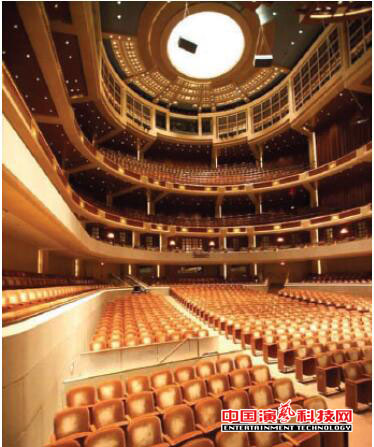 2.2 Experimental results analysis of the reverberation time of 1.5s signal of music emotional perception of the intensity is set to 1, by the subjective evaluation of the results of the results of each signal emotional perception scale relative to the reference signal strength multiple, found that some of these scatter The trichloro can be better fitted. The curves of the same kind of emotional repertoire are observed together, and the curves with inconsistent curves are marked with dashed lines. It is found that most of the similar emotional senses of emotion affect the consistency trend with the reverberation time. To Figure 5.
2.2 Experimental results analysis of the reverberation time of 1.5s signal of music emotional perception of the intensity is set to 1, by the subjective evaluation of the results of the results of each signal emotional perception scale relative to the reference signal strength multiple, found that some of these scatter The trichloro can be better fitted. The curves of the same kind of emotional repertoire are observed together, and the curves with inconsistent curves are marked with dashed lines. It is found that most of the similar emotional senses of emotion affect the consistency trend with the reverberation time. To Figure 5.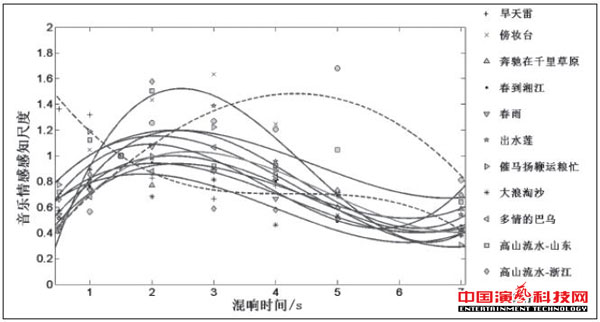 The effect of reverberation on emotional perception of happy music
The effect of reverberation on emotional perception of happy music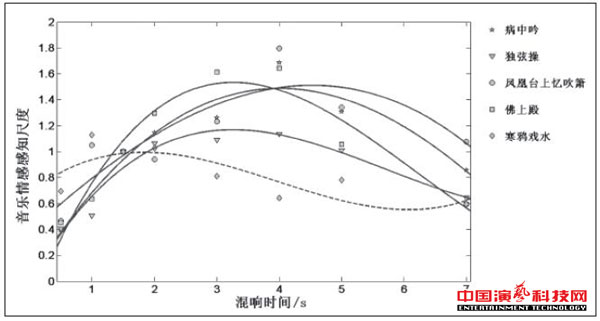 Figure 2 Reverberation on the affective perception of sad music
Figure 2 Reverberation on the affective perception of sad music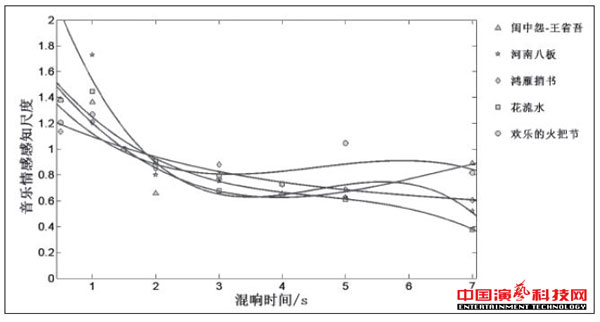 Figure 3 Reverberation on the affective perception of leisure music
Figure 3 Reverberation on the affective perception of leisure music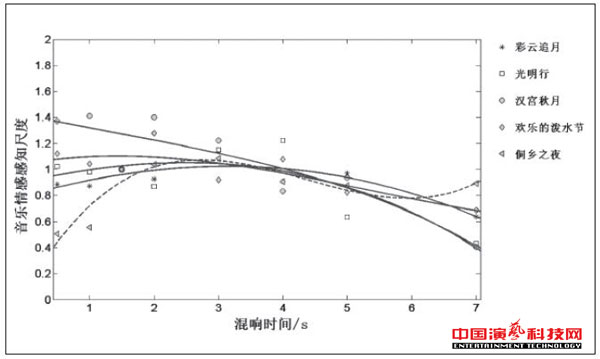 Figure 4 Reverberation on the impact of soft music perception
Figure 4 Reverberation on the impact of soft music perception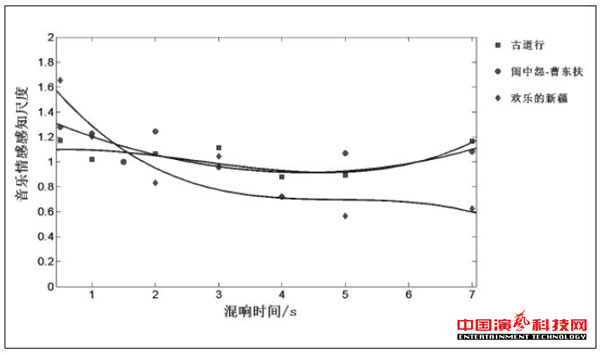 The effect of reverberation on the perception of each emotional perception is obvious, that is, for the joy, sadness, leisure, soft and sacred class of music, their emotions Perceptions often show a particular pattern as the reverberation time changes. Remove the individual perception of the law is not consistent with the track, the other tracks of the emotional value of the average, get each type of emotion with the reverberation time trend of the fitting chart, as shown in Figure 6.
The effect of reverberation on the perception of each emotional perception is obvious, that is, for the joy, sadness, leisure, soft and sacred class of music, their emotions Perceptions often show a particular pattern as the reverberation time changes. Remove the individual perception of the law is not consistent with the track, the other tracks of the emotional value of the average, get each type of emotion with the reverberation time trend of the fitting chart, as shown in Figure 6.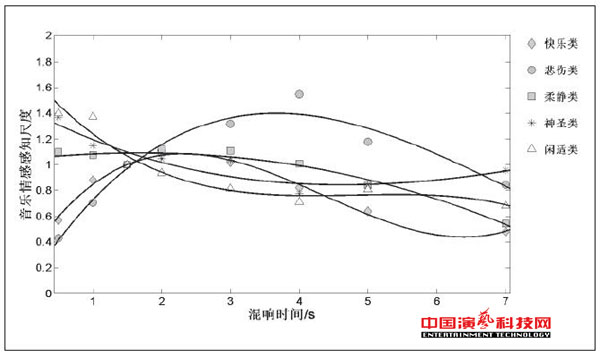 Figure 6 Reverberation on the impact of various types of music emotional perception According to the above figure can be found in the 7s reverberation time, with the reverberation time becomes larger, all kinds of music emotional perception of the strength of the changes are as follows: (1) Class music emotional perception of the strength of the trend is rising and then down. Reverberation time is 2 s when the emotional perception is the strongest, the reverberation time is 6 s when the emotional perception is the weakest; (2) sadness music emotion perception trend is rising and falling again. (3) the softness of the emotional feeling of soft music is about 3 seconds before the gentle, and then decline; (4) leisure music emotional perception of the strong Weak trend is about 4 s before the decline, and then more gentle; (5) holy music emotional perception of the strength is the first decline and then rise, reverberation time around 4s when the emotional perception of the weakest.
Figure 6 Reverberation on the impact of various types of music emotional perception According to the above figure can be found in the 7s reverberation time, with the reverberation time becomes larger, all kinds of music emotional perception of the strength of the changes are as follows: (1) Class music emotional perception of the strength of the trend is rising and then down. Reverberation time is 2 s when the emotional perception is the strongest, the reverberation time is 6 s when the emotional perception is the weakest; (2) sadness music emotion perception trend is rising and falling again. (3) the softness of the emotional feeling of soft music is about 3 seconds before the gentle, and then decline; (4) leisure music emotional perception of the strong Weak trend is about 4 s before the decline, and then more gentle; (5) holy music emotional perception of the strength is the first decline and then rise, reverberation time around 4s when the emotional perception of the weakest.








